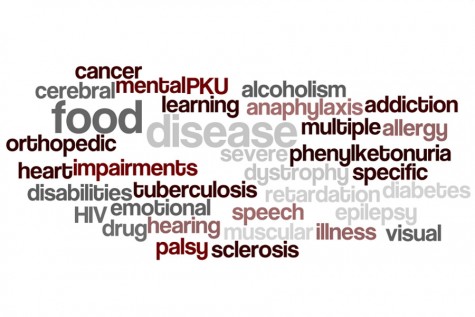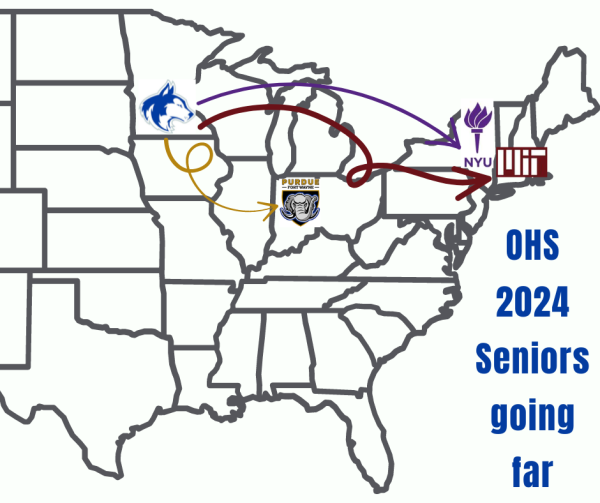No tolerance for food intolerance
Food intolerances are on the rise
When one walks through the OHS cafeteria, there is the school food and then there are the students. For some, school food makes them sick. Not in the typical commentary of “Ew…this is gross.” The food literally makes them physically ill. There are many students at OHS that suffer from food intolerances and/or diseases that restrict their diets. Some days, the food served at school is able to be eaten by these students. Other days, it is not. How does the Owatonna School District accommodate these students? What are the laws to provide for these students who have special dietary restrictions?
Food allergies and intolerances among children have increased approximately 50% between the years 1997 and 2011.
— Centers for Disease Control
In recent years, the occurrence of diseases requiring restricted diets and food intolerances has skyrocketed. Some researchers and medical professionals attribute it to the amount of unhealthy food we eat. Others attribute it to the food itself- genetically modified and no longer the natural food our bodies were accustomed to. Regardless, it still remains that more and more people have food intolerances. Many of those people are students in high school. In the OHS, there are numerous students who have special dietary needs.
Federal law states, “Substitutions to the regular meal must be made for children who are unable to eat school meals because of their disabilities.” That leads to the question, well, what IS a disability? In the Rehabilitation Act of 1973, Section 504, the law defines a disability as “persons with a physical or mental impairment which substantially limits one or more major life activities. People who have a history of, or who are regarded as having a physical or mental impairment that substantially limits one or more major life activities, are also covered. Major life activities include caring for one’s self, walking, seeing, hearing, speaking, breathing, working, performing manual tasks and learning.” Some diseases found in the high school setting that would fall into this definition are orthopedic, visual, speech and hearing impairments; cerebral palsy; epilepsy; muscular dystrophy; multiple sclerosis; cancer; heart disease; metabolic diseases, such as diabetes or phenylketonuria (PKU); food anaphylaxis (severe food allergy); mental retardation; emotional illness; drug addiction and alcoholism; specific learning disabilities; HIV disease; and tuberculosis.

For students suffering from these diseases, the school district is required by law to provide other food for them. However, the law only requires schools to provide special meals for students who have a disease or life- threatening allergy. For students with a general intolerance, such as a gluten or fructose intolerance, provisions are not required. The school may choose to provide special meals for these students, but by law, they do not have to. For those students who suffer from an intolerance, eating school lunches may be extremely difficult. OHS junior Gabrielle Zeman suffers from a severe fructose intolerance. “If I eat too much fructose, I’ll throw up or faint. I can rarely go through the main line. I have to go through another line and pay more so I can eat.”
The ISD 761 school district’s registered dietitian Alison Galzki said, “It is our current district policy to only make special accommodations for students with special dietary needs who are considered to have a disability. The financial and personnel requirements to satisfy the dietary needs of potentially 4900 students are not within the realm of possibility for our district.” Yet, a presentation given by the United States Department of Agriculture Food and Nutrition Service said, “In most cases, children with disabilities can be accommodated with little extra expense or involvement.” The federal government encourages school food services to “provide food substitutions or modifications for children without disabilities with medically certified special dietary needs who are unable to eat regular meals as prepared.”
If a student and their parents wish to have the school provide for their non- disabled child’s special dietary needs, there is a legal process they will have to go through. The special dietary request must be supported by a statement explaining why the food substitution is being requested. The medical statement, signed by the student’s doctor, must identify the medical or special dietary condition, the food(s) to be omitted, and the food choice(s) to replace it. Completing this process, however, does not mean the school will decide to provide for the student. According to Part B of the Individuals with Disabilities Education Act (IDEA), school food and nutrition services “may make food substitutions, at their discretion, for individual children who do not have a disability, but who are medically certified as having a special medical or dietary need. Such determinations are only made on a case-by-case basis. This provision covers those children who have food intolerances or allergies but do not have life-threatening reactions (anaphylactic reactions) when exposed to the food(s) to which they have problems.”
If I eat too much fructose, I’ll throw up or faint. I can rarely go through the main line. I have to go through another line and pay more so I can eat.
— Junior Gabi Zeman
According to a report released by the Centers for Disease Control in 2013, food allergies and intolerances among children (age 18 and younger) have increased approximately 50% between the years 1997 and 2011. Gluten intolerance alone affects 18 million Americans. These intolerances and allergies combine to affect one in every 13 children. In school terms, that means probably two students in every class suffer from a special dietary restriction. For students who need special modifications to school food, the replacement food can be a game- changer. As these food issues continue to arise in the lives of high school students, staff and students alike need to be aware of this issue, especially as it becomes more and more prevalent.

I am the editor of Magnet.
I love cows, exact change, and Eeyore.
I am Mrs. Wagner's favorite.





